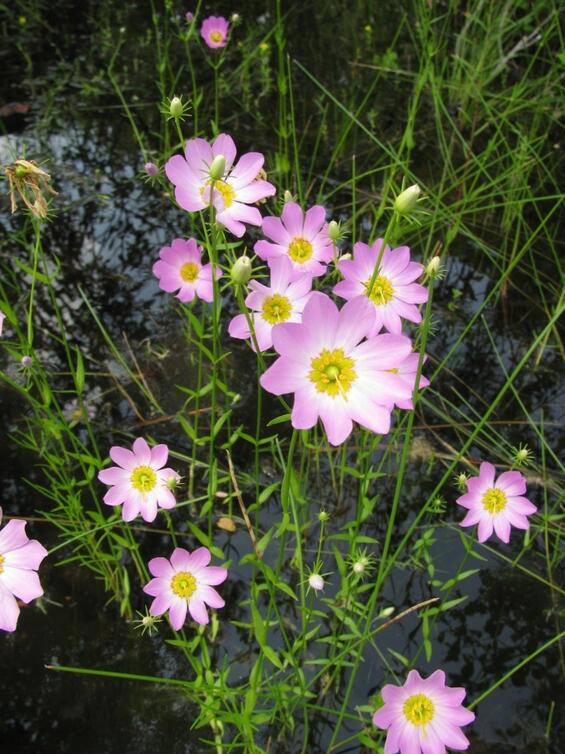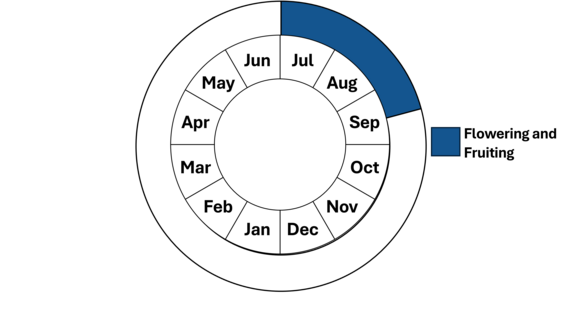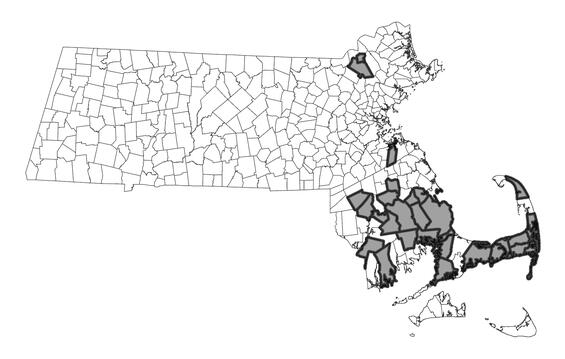- Scientific name: Sabatia kennedyana Fernald
- Species of Greatest Conservation Need (MA State Wildlife Action Plan)
- Special Concern (MA Endangered Species Act)
Description

Plymouth gentian (Sabatia kennedyana). Photo credit: Jennifer Garrett
Plymouth gentian (Sabatia kennedyana) is a globally rare and showy perennial herb of the gentian family (Gentianaceae), with striking pink and yellow flowers and opposite lance-shaped leaves. It inhabits the sandy and peaty shorelines of coastal plain ponds.
Plymouth gentian reaches 30-70 cm (12-28 in) in height, with opposite branches bearing narrowly lanceolate leaves. The leaves are entire, sessile, and 2-5 cm (0.8-2 in) in length. The flowers, which form atop long pedicels, are pink with a yellow center bordered by red; they have 9 to 11 petals, each of which is 1.5-3 cm (0.6-1.1 in) in length. Plymouth gentian blooms between early July and mid-September, depending on when the water level of the site decreases enough to expose adequate shoreline. The fruit is a capsule with two valves.
Slender marsh pink (Sabatia campanulata, endangered) occurs in similar habitat in Massachusetts but has only 7 or fewer petals per flower. Rose coreopsis (Coreopsis rosea), another showy flower of coastal plain pondshores, is somewhat similar to Plymouth gentian due to its radial pink and yellow inflorescence. Rose coreopsis, however, is a composite (family Asteraceae) with disc and ray flowers, and linear, rather than lanceolate, leaves.
Life cycle and behavior
This is a perennial species.

Population status
Plymouth gentian is listed under the Massachusetts Endangered Species Act as a species of special concern. All listed species are legally protected from killing, collection, possession, or sale, and from activities that would destroy habitat and thus directly or indirectly cause mortality or disrupt critical behaviors. Plymouth gentian is currently known from Barnstable, Essex, Norfolk, and Plymouth Counties, and is historically known from Nantucket County.
Distribution and abundance
Plymouth gentian is a globally rare species and has a very limited and disjunct range. It is found in the coastal plain areas of Nova Scotia, Massachusetts, Rhode Island, North Carolina, South Carolina, and Virginia. It is most common in Massachusetts where it is considered vulnerable; it is critically imperiled in North Carolina and Rhode Island, and imperiled in Nova Scotia and South Carolina.

Distribution in Massachusetts. 2000-2025. Based on records in the Natural Heritage Database.
Habitat
Plymouth gentian grows along the seasonally wet, sandy to peaty soils of low-nutrient, acidic, coastal plain pondshores. It prefers full sun and does not compete well with shrubs; therefore, fluctuating water levels are important for the persistence of this species at a site. Associated species include golden hedge-hyssop (Gratiola aurea), pond-shore rush (Juncus pelocarpus), slender-leaved goldenrod (Euthamia tenuifolia), toothed flatsedge (Cyperus dentatus), and rose coreopsis (Coreopsis rosea). Several rare species can be associated with Plymouth gentian, including long-beaked bald-sedge (Rhynchospora scirpoides, special concern), short-beaked bald-sedge (Rhynchospora nitens, threatened), Torrey’s beak-sedge (Rhynchospora torreyana, endangered), terete arrowhead (Sagittaria teres, special concern), and Wright’s panic-grass (Dichanthelium wrightianum, special concern).
Healthy habitats are vital for supporting native wildlife and plants. Explore habitats and learn about conservation and restoration in Massachusetts.
Threats
Plymouth gentian is threatened by any activity that changes the hydrologic regime, water, quality, or soil integrity of the coastal plain pond it inhabits. Region-wide, coastal plain ponds are imperiled due to shoreline development, water table drawdown (from wells), eutrophication (resulting from fertilizers and septic systems), and soil disturbance from heavy recreational use (ORV, horse, and foot traffic; camping; boat-launching; raking and digging).
Conservation
Management of Plymouth gentian requires protection of the hydrology, water quality, and soil integrity of its habitat. Like many other coastal plain pondshore plant species, Plymouth gentian requires pronounced water-level fluctuations; acidic, nutrient-poor water and substrate; and an open, exposed the shoreline, free from major soil disturbance. The hydrologic regime is particularly important; coastal plain pond shore species often require low water years for reproduction, but their persistence at a site depends on high water years to keep dense woody vegetation from taking over the shoreline. Protection of Plymouth gentian habitat may require regulation of new wells, exclusion of septic systems, prohibitions on fertilizer use, and restrictions on recreational use of the site. Recreational activities such as swimming, hiking, horseback riding, and ORV use should be diverted from the plant population location by re-routing trails, installing fences, and providing alternative locations for the activities.
Populations should be monitored to identify threats such as over-shading, invasive plant establishment, and soil disturbance. Plymouth gentian is most likely to be observed in the middle to late summer when water levels have decreased to expose the shoreline. Sites that have encroaching woody vegetation could be carefully thinned after the growing season (November–April).
Habitat sites should be checked for the early stages of exotic plant species invasions. The low-nutrient, acidic shores inhabited by Plymouth gentian are generally inhospitable for many exotic invasive plants, but invasives could become established at sites that have received heavy soil disturbance or nutrient input. Exotic species that could establish at such sites include common reed (Phragmites australis ssp. australis), gray willow (Salix cinerea), and purple loosestrife (Lythrum salicaria). To avoid inadvertent harm to rare plants, all active management of rare plant populations should be planned in consultation with MassWildlife’s Natural Heritage and Endangered Species Program.
Contact
| Date published: | April 30, 2025 |
|---|